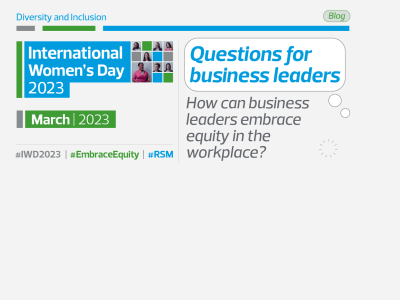Buhle Dlamini, a cultural intelligence and diversity expert for TomorrowToday Global, examines the vital importance of going beyond traditional D&I frameworks and embracing ‘difference’, to build effective teams and organisations.
When it comes to D&I (Diversity & Inclusion) frameworks, there is a growing fatigue that could see us all risk losing the value of our differences in the workplace. So, how can we move beyond conventional D&I thinking and fully utilise the power of embracing difference?
Leaders within today's global economy will already understand the importance of embracing D&I as a fundamental part of doing business today. Every organisation that cares about its future must have a D&I framework in place to create an environment in which, to paraphrase Verna Myers, people are not only invited to the party but are asked to dance.
There is a rising need to build on the traditional foundations of D&I for teams to reap the benefit from the “difference” that every individual brings. While D&I focuses on making sure that everyone is represented and integrated into an organisation, harnessing “difference” means leveraging the advantages that come with it. This means equipping teams with the right skills to successfully navigate the benefits that team members from diverse backgrounds, cultures and perspectives bring to the workplace.
In this rapidly evolving business environment, organisations must keep up with the continuous change and disruption that is shaping the future of commerce.
In the natural world, embracing difference is a key characteristic for organisms which ultimately adapt to the changing environment around them. The same principal applies within organisations. This concept is no longer just about bringing different people together, it is about creating an ecosystem where difference is not simply a problem to be solved but a competitive asset to be leveraged.
What difference matters most?
If we are to harness and leverage the difference in our teams, what differences matter most? From hairstyles to personalities, cultures to abilities and races to genders - difference can mean anything and everything. With that in mind, there are two crucial components to focus on.
Visual Diversity
Visual diversity refers to the differences that we can see such as race, age, gender, ethnicity and ability. This is significant because, as humans, we tend to put people in the “in-group” when we identify with them. For anyone that we do not identify with, we place in the “out-group”, influenced often based on what we physically see.
Visual diversity forms the basis for our biases both explicit and unconscious. Harnessing the power of visual differences means disrupting unconscious bias and embracing the value that each distinctive team member brings.
In order to do this, it is important for us to first understand our unconscious biases, which can take the form of implicit stereotypes; affinity and confirmation biases; or halo and horn effect biases amongst many others.
Under-represented groups
Any group that is less recognised, in one subset than the general population, regardless of whether they are visibly different, comes under the “underrepresented” title. Anyone who is part of an underrepresented group fundamentally experiences two things - the fear to speak up or challenge, and the sense of being futile. An individual can be part of the underrepresented group at the management level of an organisation, whilst being part of a majority in the rest of the organisation.
Effective teams and leaders must pay attention to the voices of underrepresented members and ensure that they are not overlooked. This is not about ‘otherising’ those that are different, it is about inviting and championing everyone’s contribution.
How can teams harness difference successfully?
It is not enough to simply be cognisant of the differences that exist within teams. Leaders must look to build skills and capabilities in individuals. Cultural Intelligence (CQ) is the capability to function and relate effectively in culturally diverse situations. As teams grow, become more collaborative and work across borders, this form of intelligence becomes increasingly critical.
CQ offers a way of developing and measuring one’s capability to work effectively across any number of cultural contexts including cultural identity, work styles, orientation, generations and gender. It is easy to only think of ‘culture’ from an ethnicity or nationality perspective but CQ is much broader. Culture then, in this context, is whatever is accepted and familiar to a particular group or subset.
There are 4 CQ (Cultural Intelligence) capabilities:
- CQ Drive: Level of interest and confidence in cross cultural interactions.
- CQ Knowledge: Understanding of how cultures are similar and different.
- CQ Strategy: Awareness and ability to plan for multicultural settings.
- CQ Action: Ability to adapt to different settings or cultures.
While D&I efforts seek to redress the real inequities that exist in the workplace, because of historic and systemic injustices, CQ equips individuals to navigate differences between people more holistically. Unlike IQ, CQ can be developed, meaning that cultural intelligence can grow over time and experience.
1. CQ Drive:
CQ drive measures the level of interest, persistence and confidence in different cultural contexts. A person with a high CQ drive finds interacting with people that are different exciting, interesting and rewarding. They seek out different expressions and experiences and are confident in engaging with alternative perspectives. CQ drive can be enhanced by reading books, stories or watching films from and about a particular group of people, in order to understand them better. Taking part in sports or activities that they are interested in, trying foods that they eat and simply talking to these groups are all beneficial to enhancing CQ.
2. CQ Knowledge
It is not enough to just have interest in those who are different, it is important to increase the knowledge of how people are both different and similar which is where CQ comes in. CQ knowledge provides insight into why people from a different context think and behave the way they do - bearing in mind that not everything is always a reflection of one’s cultural background or perspective.
To increase CQ knowledge, it is crucial to become familiar with different historical contexts that have affected people. For example, a team member based in a North American context may find it difficult to understand that ‘yes’ doesn’t always mean ‘yes’ when engaging with team members based in Asia or Africa. Sometimes, people from high context and high-power distance cultures may not give a straight ‘no’ as it is considered rude. This is just one example of how sociolinguistics can stand in the way of harnessing difference. By spending more time increasing CQ knowledge (asking, listening, learning) difference can be navigated more successfully.
3. CQ Strategy
CQ strategy is the awareness and ability to plan for multicultural interactions and ensures that CQ drive and CQ knowledge translate into intercultural effectiveness. We tend to think very little about what kind of words, expressions and gestures we use and what is appropriate in unique settings. CQ strategy helps guide us through differences with proper planning and execution.
A person with a high CQ strategy thinks carefully about their approach when engaging in different contexts. They think about who is present, what is culturally acceptable or offensive for those people, what to avoid and what to highlight. Ultimately CQ strategy is about developing sensitivity and thought to our interactions, not only through planning but through awareness and adjusting appropriately.
4. CQ Action
CQ action brings all the components together as the ability to adapt when relating to and working with those who are different. The best way to increase CQ action is through practice. The more we adapt in different cultural settings, the easier it becomes to work with different people. Over time we can learn to adjust how we communicate in different contexts, we learn what is offensive, how to pay sincere compliments and what gestures and facial expressions are appropriate for different settings.
The future of managing difference
Everyone is responsible for driving their ability to work well with difference in the workplace, regardless of culture, race, gender, generation or orientation. We can all play a role in creating an inclusive environment where everyone can be who they really are, be understood and appreciated.
Ultimately, the journey begins with first seeking to understand before being understood whilst viewing difference as an asset rather than a challenge. Together, we can make it happen.







